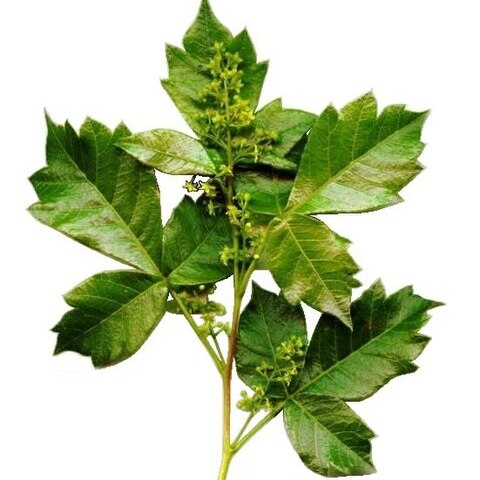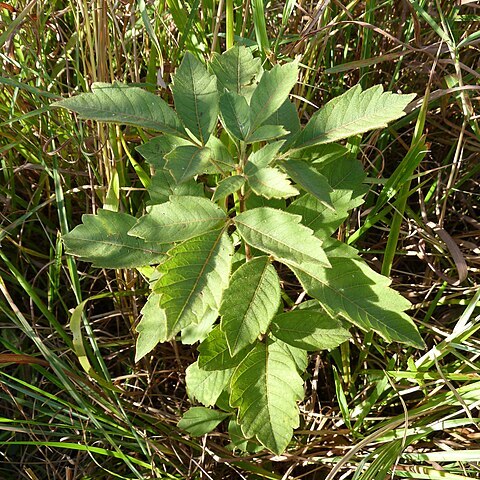Leaves petiolate; leaflets sessile, obovate, coarsely inciso-dentate, cuneate at base and quite entire, glabrous on both sides; axillary racemes short, terminal ones longer, paniculated; drupe globose, glabrous. An erect shrub, with scabrous branches and short, rigid, or elongated, often unilateral branchlets. Petioles 6-9 lines long, or shorter. Leaflets sessile or a little petiolulate, of the same colour on both sides, or paler beneath, with prominent veins, the margins pale, whitish, teeth 3-7, mucronate; terminal leaflet very cuneate, in some specimens inch long, 8-10 lines wide, in others 5-6 lines long, 3-4 wide; lateral leaflets smaller, ovate or obovate. Axillary racemes about 0.5 inch, the terminal ones 1-2 inch, more compound, with patent lower branches; pedicels capillary. Flowers small. Drupe shining, the size of a small pea.
Villous, branchlets short; leaves petiolate; leaflets sessile, obovate or elliptic, wedge-shaped, 3-7 dentate at the point, teeth mucronulate; panicles axillary, and terminal, short, of the length of the leaves or a little longer; calyx villous. A small shrub. Flowering branches 1-2 inches, the sterile ones longer and more yellowish. Petioles in the sterile branches 0.5-1 inch long, with leaves of the same length, and 6-10 lines wide; petioles in the flowering branches 2-3 lines long, with greenish leaves 3-5 lines long, 3-4 lines wide. Panicles pauciflowered, about 0.5-1 inch long; pedicels capillary, 4-i line long. Petals white, twice as long as the calyx.
A shrub or small tree. It grows to 6 m high. The branches are grey. The foliage is soft. The twigs are red or yellow. The leaves have 3 leaflets. The leaves on on long leaf stalks. The leaves are thin and dark green on top and lighter underneath. The central leaflet is 2.5-5 cm long or it can be 8 cm long. It is oval and narrows to the base. The upper parts of the leaf has bold teeth along the edge. The flowers are small and yellow. They have a sweet smell. The flower clusters are in the axils of leaves or at the ends of branches. The fruit is small and round. It turns red or orange. The fruit are edible.
Tree or shrub, 0.5-6.0 m high; much branched, deciduous, bark dull grey-brown, smooth; young branchlets brown to greyish. Leaves petiolate, trifoliolate; leaflets sessile, membranous, pale to dark green above, paler below, turning dull yellow to orange-red in autumn, obovate to widely obovate, margins dentate with (1-)3(-5) mucronulate teeth in upper half. Inflorescence terminal or axillary panicles, glabrous or pubescent, much branched. Flowers: styles slightly connate at base. Flowering time Oct.-Mar. Fruit a drupe, globoid, glabrous, pale to dark brown.
Dwarf shrub, shrub or small tree, up to 5 m high, glabrous to pubescent. Leaflets sessile; blade obovate to broadly obovate, margins prominently dentate with 1-5 mucronulate teeth in upper half; (10-)26(-43) x (9-)17(-30) mm. Flowers: corolla yellow; Sep.-Jan. Fruit a globose, glabrous drupe.
Dwarf shrub, shrub (1-2 m) or small tree, up to 5 m high, glabrous to pubescent. Leaflets sessile, obovate to broadly obovate, base cuneate, margin prominently dentate with 1-5 mucronulate teeth in upper half. Flowers yellow.
Dioecious, deciduous shrub to 2 m. Leaves trifoliolate, leaflets sessile, broadly obovate, margins prominently dentate. Flowers yellow. Drupes round, shiny.



